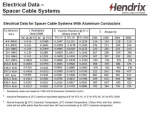mbrooke
Batteries Included
- Location
- United States
- Occupation
- Technician
When would you use a 140% trip coil? What about a 200% for the matter?
Basic characteristics W-group reclosers are hydraulically controlled protective devices in which tripping is initiated by a series trip coil that releases the stored-energy trip mechanism when an overcurrent occurs. Current-carrying and interrupting capacities depend on the rating of the recloser series trip coil. Minimum-trip current is 200% of the coil rating, except X coil ratings which initiate tripping at approximately 140%.

